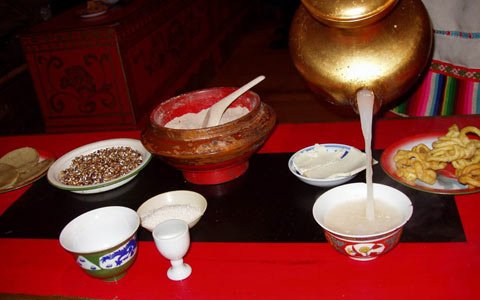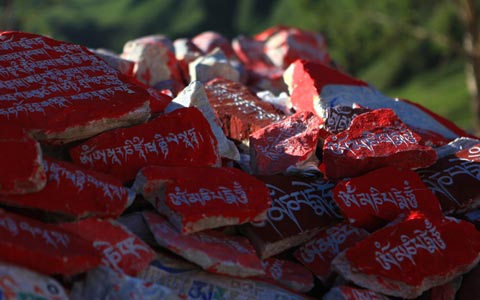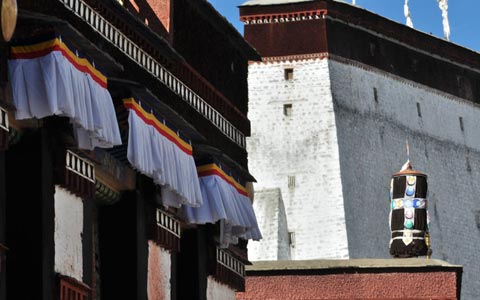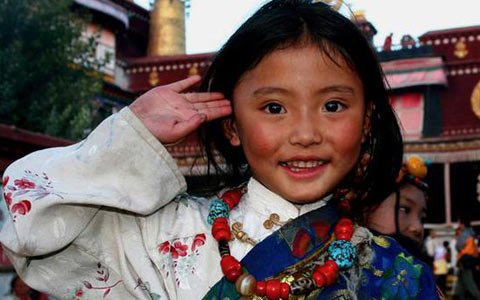Tibetan Wedding: What is a Traditional Tibetan Wedding Ceremony Like?
Tibetan weddings are a captivating blend of spirituality and culture. Amidst the stunning Himalayan landscapes, these ceremonies hold profound meaning for the Tibetan people. In this article, we'll unveil the customs, rituals, and beliefs that make traditional Tibetan weddings so unique. From elaborate preparations to sacred vows, let's embark on a journey into the heart of the Tibetan wedding ceremonies.
 Does the Arranged Blind Wedding Still Exist in Tibet?
Does the Arranged Blind Wedding Still Exist in Tibet?
 What Types of Tibetan Wedding Ceremony are Celebrated Today, Modern or Traditional?
What Types of Tibetan Wedding Ceremony are Celebrated Today, Modern or Traditional?
 What is the Traditional Tibetan Wedding Ceremony Like? And How Long Lasts?
What is the Traditional Tibetan Wedding Ceremony Like? And How Long Lasts?
 How to Make a Proposal in Tibet?
How to Make a Proposal in Tibet?
 What is the Engagement Ceremony Like in Tibet?
What is the Engagement Ceremony Like in Tibet?
 More Activities and Rituals after the Wedding Ceremony
More Activities and Rituals after the Wedding Ceremony
Does the Arranged Blind Wedding Still Exist in Tibet?
In the past in Tibet, most marriages were arranged. Parents had the responsibility of raising and arranging marriages for their children, and the children had the obligation to obey and honor their parents. When finding a bride or groom, the children had no right to inquire, especially women, who often went to their husbands' homes without even knowing what their husbands looked like.
However, in modern Tibet, most marriages are now based on free choice. Men and women have the freedom to fall in love and, when they decide to get married, they inform their parents and follow customary procedures before ultimately tying the knot.
What Types of Tibetan Wedding Ceremony are Celebrated Today, Modern or Traditional?
Today, Tibetan people no longer rely on arranged marriages orchestrated by their parents but rather make independent choices in love and marriage. However, they still largely adhere to the traditional procedures of proposal, engagement, and wedding ceremonies that have been passed down through generations.
Tibetan traditional wedding ceremonies are characterized by their grandeur and solemnity. During these ceremonies, the bride and groom go through numerous traditional rituals and customs that serve not only as tests but also as blessings and expectations for their future together.
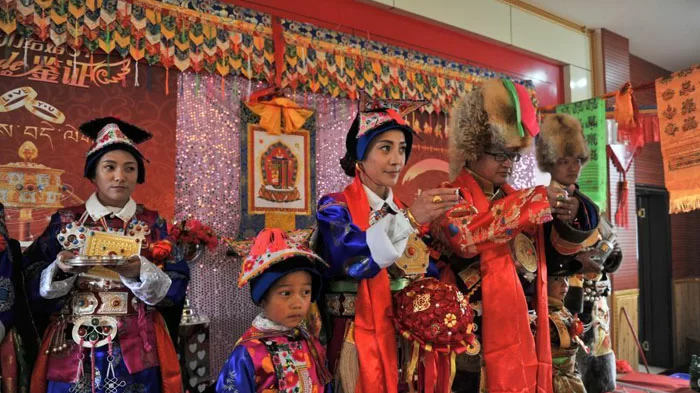 Tibetan traditional wedding ceremonies are characterized by their grandeur and solemnity.
Tibetan traditional wedding ceremonies are characterized by their grandeur and solemnity.
Despite being traditional, Tibetan weddings are evolving with the changing times. While maintaining the core of traditional customs, many outdated norms are fading away, making way for modern elements to blend in. For instance, horseback rides may be replaced with carriages, making these weddings both convenient and magnificent.
What is the Traditional Tibetan Wedding Ceremony Like? And How Long Lasts?
Before the wedding, another auspicious day will be chosen for the wedding ceremony by the groom's family. On the previous day of the wedding ceremony, the groom's side sends a suit of beautiful clothing and a hair ornament wrapped in silk to the bride for her to wear.
On the wedding day, the groom's side will find a man of good status to lead a group of people, along with colorful arrows decorated with mirrors, jades, and jewels, and a finely decorated horse of pregnancy whose color matches the bride's zodiac sign to the bride's house. The bride's side will offer Qiema as a ritual of farewell before the groom's welcoming group arrives.
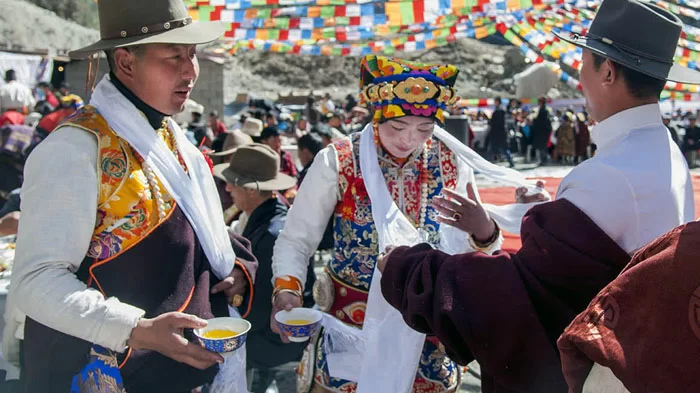 Tibetan newlyweds are receiving Khatags at the wedding ceremony.
Tibetan newlyweds are receiving Khatags at the wedding ceremony.
As the groom’s welcoming group arrives, a colorful arrow will be pinned to the bride's back, and a jade will be placed upon her head to symbolize that she now belongs to the bridegroom's side. A bride's maid from the bride's side is sent to escort her as part of the welcoming group. When the bride leaves, someone from the bride's family will hold a colorful arrow in one hand and a mutton leg in the other, standing in a high place and shouting "Don't take away the fortune of the family" until the bride's welcoming group is out of sight.
The welcoming group is usually led by the astrologist, who wears a white gown. He rides on a white horse and holds a picture of the Nine Courts and Eight Diagrams. Following behind are the welcoming group, the bride accompanied by a bride's maid on her side, and finally, members of the groom at the end. The whole team sings loudly all the way while the bride weeps due to her separation from her family.
On the way, the family members of the bridegroom wait beside the road and toast to the welcoming group three times. If they come across patients being carried, people dumping garbage, or individuals carrying empty baskets, the welcoming group deems it as a bad omen. If so, monks should be invited to chant scriptures to remove ill fortune after the wedding days. All welcoming members continue chanting XieQin as the procession proceeds while the bride is crying.
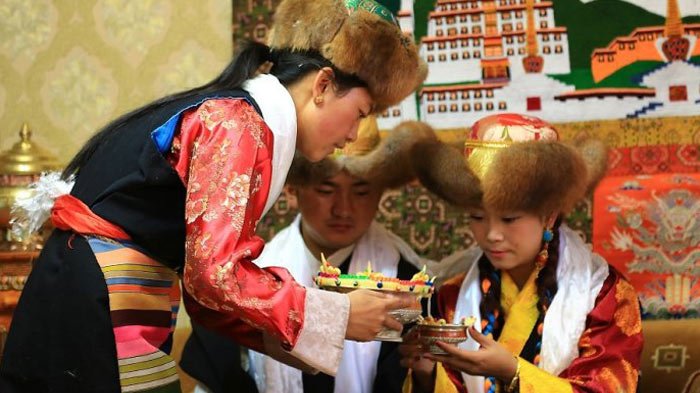 Toasting for Happiness and Harmony during a Tibetan Wedding
Toasting for Happiness and Harmony during a Tibetan Wedding
Before the arrival of the bride, the groom would have the gate decorated, and a cushion of barley laid in front of his house. The cushion is covered with a piece of colorful embroidered cloth, on the top of which are some kernels in the shape of the propitious swastika. His family members welcome the bride with chang and chemar (a propitious funneled box with barley and Tsambas separately placed inside, and butter sculptures attached).
Upon the arrival at the groom's house, the bride has to walk on a path covered with barley and tea leaves, symbolizing the harvest she is bringing into the family. After accepting the Khatag presented by the groom, she enters the house. The bride and groom then sit together in the living room to receive good wishes, Khatag, and other gifts from guests. Then the newlyweds are sent to their room, where lamas recite sutras to bless them. The family holds a banquet for the guests, during which friends and relatives sing and dance to celebrate.
For some affluent families, Tibetan wedding ceremonies could last as long as thirty days, but generally, they last three days or two days.
How to Make a Proposal in Tibet?
A proposal is the first step in Tibetan marriage. Traditionally, if a man is interested in a lady, he will inquire about her age, date of birth, and her zodiac attribute (i.e., mouse, ox, tiger, rabbit, dragon, snake, horse, sheep, monkey, chicken, dog, or pig). With all the information at hand, he will consult an astrologist to check if their attributes are compatible.
If both zodiac signs match, the man's family will choose an auspicious day and engage a matchmaker to visit the girl's family for the formal proposal, bearing gifts such as khatag, yak butter tea, barley wine, and other presents. If her family agrees, they will accept the gifts. Nowadays, the freedom to choose a spouse also prevails in Tibet.
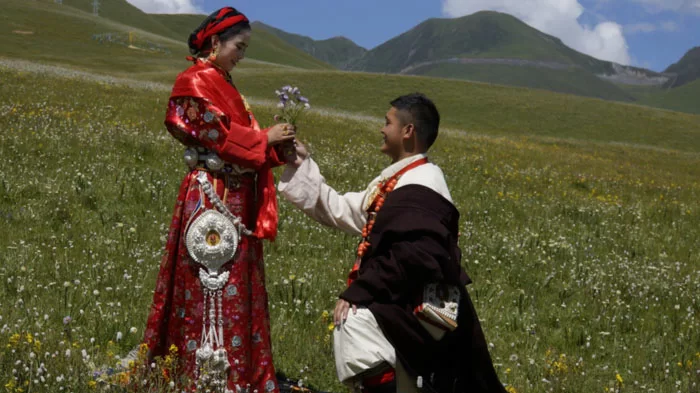 A proposal is the first step in Tibetan marriage.
A proposal is the first step in Tibetan marriage.
What is the Engagement Ceremony Like in Tibet?
If both sides agree to the marriage, they will choose another auspicious day to sign an engagement contract. The ceremony will be held at the lady's house and should be attended by representatives of both families and the chief witnesses. On that particular day, the man's family has to send Khatag and other gifts to every member of the lady's family.
The contents of the engagement ceremony revolve around mutual respect and love, demonstrating filial piety towards elders, good moral values, and the anticipation of inheriting fortune in the future, among other aspects. After the witnesses review the duplicate betrothal contracts, they will sign the contracts with the seals of the two families and pass them to both sides. Finally, the lady's family will hold a banquet to celebrate the occasion. At the end of the banquet, each guest will receive a Khatag upon leaving.
 The Engagement Ceremony in Tibet
The Engagement Ceremony in Tibet
More Activities and Rituals after the Wedding Ceremony
On the first day after the wedding, the bride and groom must wake up early to offer prayers to the household deities. During the first month of marriage, the bride is not allowed to enter her parents-in-law's room. After one month, the in-laws formally invite the newlywed couple, and from then on, the bride is free to come and go in her parents-in-law's room.
 The barley is prepared for Tibetan wedding.
The barley is prepared for Tibetan wedding.
Usually, 3 or 6 months after the wedding, the newlyweds will visit the bride's parents. The bride's family must prepare barley, swastika pictures, and other items to welcome them and exchange Khatag, yak butter tea, chemar, and other gifts. Only then is the entire Tibetan wedding ceremony considered complete.
Tips for Attending a Tibetan Wedding
When attending a Tibetan wedding, it's important to respect its traditional customs and cultural practices. Make an effort to understand and adhere to these guidelines as a way of showing your respect and admiration for Tibetan culture.
While you can take photos for memories at the wedding venue, it's important not to overdo it. Respect the privacy and personal space of the bride, groom, and other guests, and refrain from disrupting their emotional experiences during the wedding.
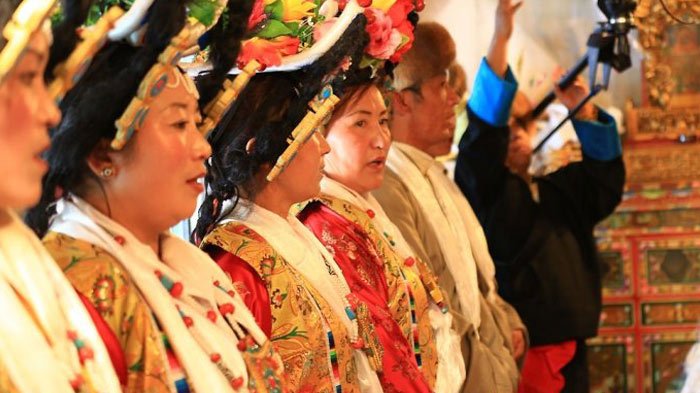 It's important to respect the traditional customs when attending a Tibetan wedding.
It's important to respect the traditional customs when attending a Tibetan wedding.
When attending a Tibetan wedding, dress appropriately to honor the solemnity and grandeur of the occasion. Avoid wearing attire that is too revealing or impolite, as it may affect the emotional experience of other guests.
By following these guidelines, your can better immerse yourselves in a Tibetan wedding and demonstrate your respect and appreciation for their culture.
Conclusion
Tibetan wedding ceremonies stand out distinctly from those in other regions, offering a glimpse into the exceptional culture of this sacred land. If fortune smiles upon you, you might even have the opportunity to participate in a local wedding celebration during your Tibet tour. For further inquiries about Tibetan weddings and other customs in Tibet, please don't hesitate to contact us. We're here to help you explore this extraordinary culture.

With exceptional passion and outstanding leadership, Mrs. Catherine has dedicated herself to Tibet inbound tourism and China tour for 15 years. As one of the handful females who see great potential of Chinese inbound tourism, Catherine has made great contribution to promoting Tibet tourism and enhancing the employment of Tibetans and prosperity of local Tibetan community.
Over the years, she travelled overseas with Tibet Tourism Bureau many times to promote Tibet tourism. Currently, Catherine works as the marketing director of Tibet Vista, an opinion leader behind the whole team of Tibet Vista.
Related Articles & Posts
Most Popular Tibet Tour Packages
-

Lhasa - Gyantse - Shigatse - Everest Base Camp - Shigatse - Lhasa
USD939
View Details -

Lhasa - Gyantse - Shigatse - E.B.C - Saga - Kailash Trek - Darchen - Lake Manasarovar - Saga - Gyirong - Tingri - Lhasa
USD2059
View Details -

10 Days Lhasa to Everest Base Camp and Namtso Lake Small Group Tour
Lhasa - Gyantse - Shigatse - EBC - Shigatse - Lhasa - Namtso Lake - Damxung - Lhasa
USD1289
View Details -

8 Days Driving Across Himalaya Overland Adventure from Kathmandu to Lhasa
Kathmandu - Gyirong - Everest Base Camp - Tingri - Shigatse - Gyantse - Lhasa
USD1069
View Details -

4 Days Lhasa Impression Small Group Tour: Explore the Heart of Tibet and Mingle with the Locals
Lhasa
USD509
View Details -

Lhasa - Gyantse - Shigatse - Everest Base Camp - Gyirong - Kathmandu
USD979
View Details -

Lhasa - Gyantse - Shigatse- Lhasa
USD799
View Details -

13 Day Lhasa, Mt. Everest, Mt. Kailash, Lake Manasarovar and Kathmandu Adventure Tour
Lhasa - Gyantse - Shigatse - EBC - Saga - Darchen - Kailash Trek - Darchen - Saga - Gyirong - Kathmandu
USD2059
View Details


.jpg)





